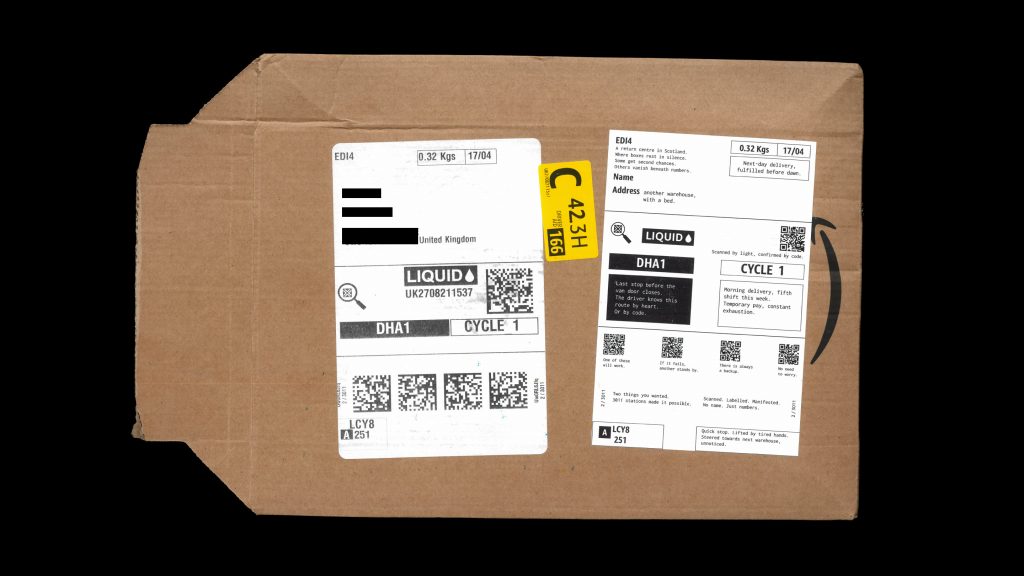Studio practices and experiments




Feedback
In the past week, I’ve reached out to three practitioners / researchers to discuss my current projects. They are Shannon Mattern, Matthew Chrislip and Rebecca. Here’s some of the key feedback.
Clarify and Deepen the Inquiry
Common thread: All three emphasised the need to clearly articulate the core inquiry and deepen it beyond personal gesture or material curiosity.
- Shannon:
- The inquiry is well-framed and not too broad.
- Postcards are promising — could improve system literacy.
- Matthew:
- What’s the anchor? Cardboard alone is not enough.
- The postcard form may lose what makes cardboard interesting — its boxiness.
- You need to clarify what the project produces as research.
- Rebecca:
- What can graphic designers uniquely contribute to the conversation around logistics?
- Are you trying to expose systems, interpret surfaces, or intervene directly?
- Postcards fragment context; boxes might carry that complexity better.
- Next steps:
- Rearticulate your inquiry as a clear tension (e.g. visibility vs. invisibility, container vs. message).
- Clarify what the project produces as knowledge, not just as artifact.
- Consider how graphic design as a discipline engages systems (labels, layout, typographic codes).
Material Strategy & Form
Common thread: Move toward a form that retains cardboard’s spatial and functional properties, or makes better use of the visual surface.
- Shannon:
- Consider stackability, dimensionality, and the color brown as entry points.
- Don’t abandon the material intelligence of the box.
- Matthew:
- Postcards flatten the object too much.
- Amazon is a powerful node — what if you recreated Amazon mailers with subversive content?
- Use labels and design language within the system, not just commenting on it.
- Rebecca:
- Postcards use a different infrastructure than parcels — consider small boxes instead.
- Track movement using GPS/AirTags to generate your own data.
- Boxes allow you to make the logistics system visible from the inside out.
- Next steps:
- Shift to box-making or reconfiguring existing boxes (standard sizes, Amazon-like).
- Use real shipping infrastructure (e.g. tracked parcels) as a publishing platform.
- Develop visual systems (labels, symbols, color codes) that both fit and critique logistics aesthetics.
Narrative, Context, and Collaboration
Common thread: Focus your storytelling on specificity — of routes, histories, infrastructures, and collaborators.
- Shannon:
- Consider the geopolitics of packaging: where things are made and moved matters.
- Matthew:
- Leverage Amazon as a central actor — its scale, contradictions, branding.
- Let your critique be less polite and more pointed.
- Rebecca:
- Consider pairing each box with its own “map” or story — create a corpus of journeys.
- Collaborate with technicians to gather real data and make it visual.
- Next steps:
- Build a visual/narrative system for tracking individual boxes and stories.
- Consider what new knowledge emerges from collectively exchanging, mapping, and interpreting boxes.
- Begin a critical visual archive: box stories, labels, metadata, mapping files, etc.
Possible Next Steps
- Print my own Amazon-inspired mailers or boxes with alternative messaging.
- Study Amazon’s box design, sticker placement, and packaging strategy—then replicate it with your own intervention.
- Explore how Amazon’s visual identity (colours, icons, names) intersects with environmental and labour realities.
- Research the history of Amazon’s logistics growth and how it shaped cardboard manufacturing.